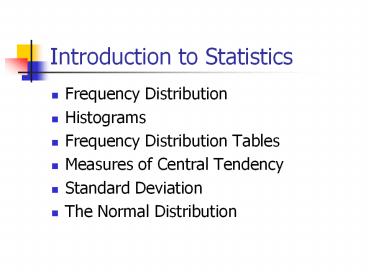Introduction to Statistics - PowerPoint PPT Presentation
Title:
Introduction to Statistics
Description:
Introduction to Statistics Frequency Distribution Histograms Frequency Distribution Tables Measures of Central Tendency Standard Deviation The Normal Distribution – PowerPoint PPT presentation
Number of Views:47
Avg rating:3.0/5.0
Title: Introduction to Statistics
1
Introduction to Statistics
- Frequency Distribution
- Histograms
- Frequency Distribution Tables
- Measures of Central Tendency
- Standard Deviation
- The Normal Distribution
2
Frequency Distribution
Assume the following data 3, 3, 4, 4, 4, 5, 7, 7, 9. Assume the following data 3, 3, 4, 4, 4, 5, 7, 7, 9.
Key Point A frequency distribution table tells us how many items are in a study and how often each item appears.
3
Histograms
Key Point In a histogram, the frequency is plotted along the y-axis and the values are plotted along the x-axis. Select the number of intervals that most nearly describe the spread of the population.
4
Frequency Distribution Tables
- Key Point
- When using intervals in a frequency distribution
table (1) intervals cannot overlap (2) data
cannot appear in more than one interval (3) the
smallest data value fits in the first interval
(4) the largest data value fits in the last
interval - (5) the width of all intervals is the same.
5
Measures of Central Tendency
Assume the following data 3, 3, 4, 4, 4, 5, 7, 7, 9. Assume the following data 3, 3, 4, 4, 4, 5, 7, 7, 9.
The mean is equal to the sum of the data divided by the number of data
The median is that value where half of the values are greater and half are less median 4
The mode is the measurement that appears most frequently mode 4
6
Standard Deviation
The standard deviation is the averaged distances of all data from the mean
7
The Normal Distribution
- Characteristics of the normal curve are
- 1. The curve is bell-shaped and has only one
peak. - 2. The shape on one side of the peak is the same
as the shape on the other side. - 3. There will be as many data points above the
mean as there are below the mean. - 4. The mean, median, and mode occur at the same
point - the peak.































